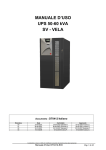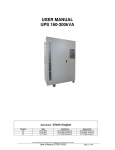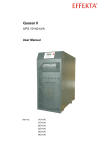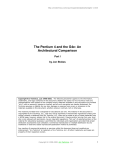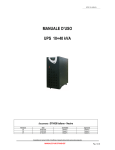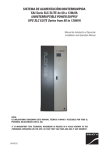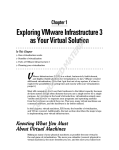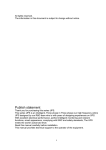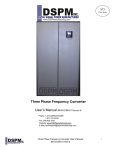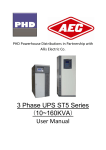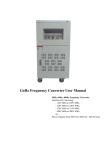Download POWERTRONIX
Transcript
POWERTRONIX UNINTERRUPTIBLE POWER SUPPLY USER MANUAL VELA 50-60 kVA Document : DT0419 English - Ptx Revision 00 Date 01-10-2007 01 02 22-10-2007 10/12/2008 Checked by 01-10-2007 Riccardo G. Darek A. 22-10-2007 Gabriele P. 10/12/2008 Andrea P. Approved by 01-10-2007 Andrea G. 22-10-2007 Andrea G. 10/12/2008 Andrea G. POWERTRONIX SpA reserves the right to modify this document without any notice R&D – PROCEDURA START-UP DT 0419 – E02 Pag. 1 di 41 INDEX INDEX ................................................................................................................................................................................2 1 UPS GENERAL INFO ..............................................................................................................................................4 1.1 UPS GENERAL DESCRIPTION .......................................................................................................................4 1.1.1 UPS APPLICATIONS ...............................................................................................................................4 1.1.2 POWER AND AUTONOMY .....................................................................................................................4 1.1.3 SAFETY AND SIMPLICITY OF USE ......................................................................................................4 1.2 CONFIGURATIONS AND OPTIONAL EQUIPMENTS...................................................................................5 1.2.1 BASE CONFIGURATION.........................................................................................................................5 1.2.2 BATTERY CABINET.................................................................................................................................5 1.2.3 TRANSFORMER CABINET.....................................................................................................................5 1.2.4 CIRCUITS FOR REMOTE COMMUNICATION .....................................................................................6 1.2.5 UPS MANAGEMENT SOFTWARE.........................................................................................................6 1.3 REMOTE PANEL................................................................................................................................................7 1.4 REMOTE E.P.O. PUSHBUTTON .....................................................................................................................7 1.5 OPERATING THEORY ......................................................................................................................................8 1.5.1 UPS BLOCK DIAGRAM ...........................................................................................................................8 1.5.2 INPUT STAGE, POWER MODULE AND OUTPUT STAGE ................................................................8 1.5.3 LOGIC AND AUXILIARY CIRCUITS.......................................................................................................9 1.5.4 BATTERIES...............................................................................................................................................9 1.5.5 MANUAL BY-PASS...................................................................................................................................9 1.5.6 FRONT PANEL .........................................................................................................................................9 2 INSTALLATION INSTRUCTIONS ........................................................................................................................10 2.1 GENERAL INFORMATIONS...........................................................................................................................10 2.2 RECEPTION AND IDENTIFICATION.............................................................................................................10 2.3 STORAGE.........................................................................................................................................................10 2.4 UPS POSITIONING..........................................................................................................................................11 2.5 ROOM SPECIFICATIONS...............................................................................................................................13 2.6 CONNECTIONS AND LAYOUT TO THE MAINS .........................................................................................14 2.7 UPS AUX CONNECTIONS .............................................................................................................................17 2.8 REMOTE COMMUNICATION BOARD ..........................................................................................................18 2.8.1 REMOTE PANEL (OPTIONAL) .............................................................................................................19 2.8.2 UPS MANAGEMENT SOFTWARE.......................................................................................................20 2.8.3 REMOTE E.P.O. PUSHBUTTON..........................................................................................................20 2.9 EARTH CONNECTION....................................................................................................................................20 3 CONTROL PANEL.................................................................................................................................................21 3.1 3.2 3.3 3.4 3.5 3.6 3.7 3.8 3.9 3.10 INTRODUCTION ..............................................................................................................................................21 LCD CONTROL PANEL...................................................................................................................................22 UPS STATES AND ALARMS VISUALIZATION............................................................................................23 MEASUREMENTS ...........................................................................................................................................24 UPS IN FAULT CONDITIONS.........................................................................................................................25 MENU 1: UPS COMMANDS ...........................................................................................................................26 MENU 2 : EVENTS HISTORY.........................................................................................................................26 MENU 3 : OPERATIVE LANGUAGE..............................................................................................................26 MENU 4: CLOCK..............................................................................................................................................26 MENU 5 : UPS CONFIGURATION ............................................................................................................26 POWERTRONIX SpA reserves the right to modify this document without any notice R&D – PROCEDURA START-UP DT 0419 – E02 Pag. 2 di 41 4 INSTRUCTIONS FOR THE UPS ..........................................................................................................................27 4.1 4.2 4.3 4.4 4.5 4.6 4.7 4.8 4.9 INTRODUCTION ..............................................................................................................................................27 POWER SWITCHES........................................................................................................................................27 UPS START-UP PROCEDURE......................................................................................................................29 INSTRUCTIONS FOR SWITCHING SYSTEM TO MANUAL BY-PASS MODE ........................................30 INSTRUCTIONS FOR RETURN FROM MANUAL BY-PASS MODE TO NORMAL OPERATION .........31 INSTRUCTIONS FOR COMPLETE SHUTDOWN OF THE UPS................................................................32 E.P.O. (EMERGENCY POWER OFF) STOP ................................................................................................32 INSTRUCTIONS FOR TURNING ON THE UPS IN POWER SAVE MODE ..............................................33 INSTRUCTIONS FOR SWITCHING SYSTEM IN POWER SAVE MODE TO MANUAL BYPASS MODE 34 4.10 INSTRUCTIONS FOR RETURN FROM MANUAL BY-PASS MODE TO NORMAL OPERATION IN POWER SAVE MODE................................................................................................................................................35 4.11 INSTRUCTIONS FOR COMPLETELY SHUTTING OFF THE UPS IN POWER SAVE MODE...........36 4.12 MANAGING THE UPS BATTERY..............................................................................................................37 5 UPS IN PARALLEL................................................................................................................................................38 5.1 6 TROUBLESHOOTING...........................................................................................................................................39 6.1 6.2 6.3 7 SYSTEM SET-UP.............................................................................................................................................38 GENERAL ALARMS.........................................................................................................................................39 CASE OF THE FIRE ........................................................................................................................................40 FAULTS RELATED TO THE LOAD................................................................................................................40 SCHEDULED MAINTENANCE.............................................................................................................................41 7.1 7.1 ANNUAL MAINTENANCE ...............................................................................................................................41 SCHEDULED COMPONENTS REPLACEMENT..........................................................................................41 POWERTRONIX SpA reserves the right to modify this document without any notice R&D – PROCEDURA START-UP DT 0419 – E02 Pag. 3 di 41 1 UPS GENERAL INFO 1.1 UPS GENERAL DESCRIPTION These UPS families have the compact construction, with the outer metal frame and the electronic circuits and power components inside. All user accessible elements an the control panel are placed on the front side. The top and side covers can be removed, giving an access to the internal part of the UPS for the service or maintenance purposes. The front side of all units contains the user interface panel useful for monitoring, maintenance and control. The UPS has a air forced cooling system, the air is going out to the back side of the cabinet. The terminal block for the electrical connection to the mains, reserve, load, external batteries, and the main circuits breakers, are located on the front side of the unit. 1.1.1 UPS APPLICATIONS The new UPS family was designed to provide stabilized and filtered power, especially for supplying sophisticated and sensitive electronic devices (i.e. for data processing systems). Vela UPSes can be used to supply electronic systems of medical centers, police stations, motorway tunnels, broadcasting stations, banks, technical and administrative offices, requiring the power source free from voltage and frequency variations. 1.1.2 POWER AND AUTONOMY Thanks to its modular design, the UPS models are available with rated power from 50kVA to 65kVA For all the size of the family are not available the internal battery, an or more external battery modules can be used to increase the UPS autonomy. 1.1.3 SAFETY AND SIMPLICITY OF USE All the UPS elements available for user daily maintenance are insulated and disconnected from hazardous voltages. Control of the overload and excessive temperatures guarantees the immediate and most suitable intervention in the case when one of these conditions occurs during operation. The operator can view the UPS status on the front panel and perform shut down or switching operations easily (see chap. 3) The unit is provided with the E.P.O. (Emergency Power Off). This function is activated by pressing the button located on the front panel. A remote E.P.O (optional) switch can be connected to UPS to provide remote emergency power off action. The UPS state can be easily monitored with the personal computer and an interacting program (optional) or through the remote panel (optional), especially when the UPS is installed in unmonitored areas. Refer to the chapters 1.2.5 - 1.2.6. POWERTRONIX SpA reserves the right to modify this document without any notice R&D – PROCEDURA START-UP DT 0419 – E02 Pag. 4 di 41 1.2 CONFIGURATIONS AND OPTIONAL EQUIPMENTS 1.2.1 BASE CONFIGURATION The UPS is available in the following configurations: - Six pulses configuration 50-60 kVA - 12 pulses configuration 50-60 kVA - 12 pulses configuration + low THD 50-60 kVA 1.2.2 BATTERY CABINET If required, the UPS can be furnish with additional optional battery cabinet to increase the autonomy All the batteries will be mounted in a separate cabinet with opportune dimensions complete of power circuit breaker and protections. 1.2.3 TRANSFORMER CABINET If required, there is available a galvanic isolating transformer, positioned in a separate cabinet. The standard transformer is three-phase/three-phase (or single-phase/single-phase or three-phase/singlephase) with 1:1 ratio, but it can be supplied with a different transformation ratio upon customer request. POWERTRONIX SpA reserves the right to modify this document without any notice R&D – PROCEDURA START-UP DT 0419 – E02 Pag. 5 di 41 1.2.4 CN3 CIRCUITS FOR REMOTE COMMUNICATION Remote communication board (the code CS0118), gives possibility of monitoring and communicating with UPS. Monitoring can be implemented with the PC and dedicated software or through a remote panel. There are also voltage free contacts available on the terminal board M1 (more info at page 18). CN1 CN4 M1 1.2.5 UPS MANAGEMENT SOFTWARE The “UPS MANAGEMENT” Generex communication software allows interaction between UPS and PC or the network based on Windows, Win-NT, Novell, OS2, Dec, and Linux operating systems. The software is used to monitor and control parameters of one or more UPS units supplying the network (more info at page 22) POWERTRONIX SpA reserves the right to modify this document without any notice R&D – PROCEDURA START-UP DT 0419 – E02 Pag. 6 di 41 1.3 REMOTE PANEL The remote panel is used for remote viewing of the UPS state; it shows the status of the main UPS blocks with LED indicators and the sound signalization in the case of alarm conditions (more info at page 21) 1.4 REMOTE E.P.O. PUSHBUTTON The remote E.P.O push-button provides the safe, remote way to fast and full disable the unit running in the event of an emergency (more info at page 22) POWERTRONIX SpA reserves the right to modify this document without any notice R&D – PROCEDURA START-UP DT 0419 – E02 Pag. 7 di 41 1.5 OPERATING THEORY The UPS described here is an on-line dual conversion type UPS, with automatic by-pass in compliance with European standard EN62040-1-2. This UPS performs the dual conversion of the incoming voltage continuously and without interruption. The absence of direct connection between mains and load eliminates the possibility of carrying disturbances from mains to the load. The dual conversion technique guarantees to the load delivering energy regulated both in voltage and frequency - thus ideal for the operation of professional applications. When the input voltage exceeds the allowed range or - more simply - is not present, the load is supplied by energy transferred from the batteries. The system is supplied with an automatic by-pass; in the event of the UPS fault or overload the by-pass connects the load directly to the mains via a reserve line, making possible maintaining normal load operation without supply interruptions. See the fig. 1.5.1 1.5.1 UPS BLOCK DIAGRAM I3 MANUAL BY-PASS MANUAL BY-PASS MANUAL BY-PASS I2 3PH + N + PE RESERVE LINE RESERVE LINE RECTIFIER - STEP UP CONVERTER INVERTER STATIC SWITCH I1 I4 MAINS INPUT OUTPUT-LOAD BATTERY CAHRGER 3PH + N + PE BATTERY CABINET Fig. 1.5.1 1.5.2 INPUT STAGE, POWER MODULE AND OUTPUT STAGE From the input bars the mains voltage is connected through the MAINS INPUT l1 switch to the power module. The rectifier-step-up converter controlled by the control logic, performs the AC/DC conversion of the mains voltage (during normal operating conditions) or the DC/DC conversion of the battery energy when the mains power is absent or not within the allowed range. The DC voltage from the converter powers the inverter module, which creates AC voltage, adjusting the current depending on the load needs. The last module is the automatic by-pass. It transfers the filtered and regenerated energy from the inverter module to the load during normal operating conditions, or - when UPS fault or overload occurs - from reserve line, still providing the energy to the load. When disappears the cause which forced UPS to switching to the reserve line, the by-pass automatically switches the load to the inverter power source. The filtered, regenerated and stabilized mains voltage supplies the load through the UPS OUTPUT (l4) switch. Refer to the figure 1.5.1 POWERTRONIX SpA reserves the right to modify this document without any notice R&D – PROCEDURA START-UP DT 0419 – E02 Pag. 8 di 41 1.5.3 LOGIC AND AUXILIARY CIRCUITS The control logic occupies the separate board (CS0119) and represents the “intelligence” of the UPS. It manages operations of the step-up converter, inverter and by-pass, based on feedback signals taken from the power module. The control logic also manages the other three boards: the battery charger, auxiliary power supply and signal interface. The battery charger handles recharging of the outside batteries connected to the UPS. The signal interface receives the signals from the control logic and converts them into the protocol required by the front panel of the UPS and also the relays board. Going backwards, the selected commands from the front panel (automatic by-pass forcing) and/or relay board (EPO) are sent from the signal interface to the control logic which interprets them and performs desired operation – like switch on/off inverter or shut down the unit. The signal interface, except controlling standard relays board, can also control another (optional) one. The auxiliary power supply supplies all the boards and electronic components in the UPS. 1.5.4 BATTERIES The battery set provides energy to the system when the input mains is out of the allowed range or not present; in all other cases batteries are constantly recharged by the charger module. In this way the batteries are always ready for use when required. 1.5.5 MANUAL BY-PASS The manual by-pass is useful in the situations, when it is necessary to disable the UPS and keep the load supplied by the mains (i.e.: UPS stopped, fault, etc.). can be activated with using the MANUAL BY-PASS (l3) switch, located in the front part of the UPS (refer to chapter 4). In normal operating conditions this circuit breaker remains in rest position, protected with the mechanical lock (the padlock). 1.5.6 FRONT PANEL The UPS can be managed via the front panel. Using the panel it is possible to execute the commands, display states and measurements and reset the alarm circuits. The panel is equipped with an LCD screen used to display the operating status of the UPS, the load and all types of measurement (see chapter 3) POWERTRONIX SpA reserves the right to modify this document without any notice R&D – PROCEDURA START-UP DT 0419 – E02 Pag. 9 di 41 2 2.1 INSTALLATION INSTRUCTIONS GENERAL INFORMATIONS This chapter describes the system installation procedures and lists the following subjects: 2.2 2.3 2.4 2.5 2.6 2.7 2.8 2.2 Reception and identification Storage UPS positioning Room specifications Arrangement and connection to mains UPS Auxiliary connections Earth connection RECEPTION AND IDENTIFICATION After removing the packing, visually inspect inside and outside the UPS and battery module (if included) to check for any damage that could occur during shipping. If there is any damage, inform the shipper or retailer immediately. Check the supplied material against the packing slip. The machine has an adhesive identification plate indicating the type, power and serial number; it is located on the right door (fig.2.2). Fig. 2.2 2.3 STORAGE If the system is not going to be installed immediately it must be stored in an environment with adequate protection against excessive humidity and sources of extreme heat (from +5 to +40°C, humidity less than 95% without condensation). If the battery module is supplied, also make sure that no more than 6 months pass between one battery recharge and the next. Once this period of time has elapsed, temporarily hook the UPS up to the mains and run it for the time needed to recharge the batteries. POWERTRONIX SpA reserves the right to modify this document without any notice R&D – PROCEDURA START-UP DT 0419 – E02 Pag. 10 di 41 2.4 UPS POSITIONING All the size and configurations are developed in the same cabinet with the characteristics described in the tables 2.4a-b-c below: 6 PULSES VERSION (STANDARD) POWER (kVA) 50 60 DIMENSIONS W x D x H (mm) WEIGHT (Kg) 530 x 950 x 1220 196 196 Tab. 2.4a 12 PULSES VERSION POWER (kVA) 50 60 DIMENSIONS W x D x H (mm) WEIGHT (Kg) 530 x 950 x 1220 330 330 Tab. 2.4b 12 PULSES VERSION + LOW THD POWER (kVA) 50 60 DIMENSIONS W x D x H (mm) WEIGHT (Kg) 530 x 950 x 1220 370 370 Tab. 2.4c For handling you need to remember that the machine, unless special arrangements are made, is shipped and thus handled, thus you need to refer to the higher weight of the version used. All the connections are located in the rear panel and can be reached by just removing the cover as shown on the fig. 2.4 POWERTRONIX SpA reserves the right to modify this document without any notice R&D – PROCEDURA START-UP DT 0419 – E02 Pag. 11 di 41 Fig. 2.4 shows the external connections. L1 L2 L3 INGRESSO PRINCIPALE N L1 L2 L3 L1 N L2 L3 N USCITA INGRESSO RISERVA + + BATT - BATT fig. 2.4 Looking at the front, the cables input is located on the lower side and accessible after opening the main UPS door (fig.2.5) For the cables connection according to the UPS configuration refer to fig.2.4 Fig. 2.5 CABLES INPUT POWERTRONIX SpA reserves the right to modify this document without any notice R&D – PROCEDURA START-UP DT 0419 – E02 Pag. 12 di 41 2.5 ROOM SPECIFICATIONS The room where the UPS is installed must be clean; it must have pollution class 2 (CEI) and must be able to dissipate the heat produced by the machine, as shown in table 2.5a. Tab. 2.5a Rated power (kVA) 50 60 Power Power dissipation (kW) 4 4.8 For correct battery ventilation, the room must be able to ensure an exchange of air equal or greater than the value shown in table 2.5b. Tab. 2.5b Air exchange only for battery hydrogen Air exchange for Air exchange for Air exchange for 15’ auton. 30’ auton. 1h auton. (m3/h) (m3/h) (m3/h) 10 19 32 Remember that the average life of the batteries is closely correlated with the operating temperature; a temperature of around 20°C is normally recommended. (when the temperature rises above 20°, for each 10° higher the battery life drops by 50%) POWERTRONIX SpA reserves the right to modify this document without any notice R&D – PROCEDURA START-UP DT 0419 – E02 Pag. 13 di 41 2.6 CONNECTIONS AND LAYOUT TO THE MAINS For connection to the mains a layout solution like the one shown in diagram 2.6 is recommended. The circuit breakers B-C-D are magnetothermic type without differential protection, or if this is required, with a triggering current greater than 0.3A, delayed and suitable for load with DC current (type A). Switch A is used as external BY-PASS. Standard reserve Standard mains Load A D DISTRIBUTION PANEL BY-PASS I3 BY-PASS B I2 RESERVE LINE RESERVE I4 OUT C I1 = INPUT = UPS Standard mains BATTERY1 I Standard reserve BT1 fig. 2.6 BATTERY CABINET POWERTRONIX SpA reserves the right to modify this document without any notice R&D – PROCEDURA START-UP DT 0419 – E02 Pag. 14 di 41 The control parts and all the power connections of the UPS in question need to be able to permanently support the current shown in tab. 2.6 UPS power (kVA) 50 60 Mains input Imax (A) 75 90 Reserve input Imax (A) 76 91 User outputs Imax (A) 76 91 Battery discharge current (A) 140 166 Tab. 2.6 WARNING !! IN ADDITION TO THE CIRCUIT BREAKER AND PROTECTION IT IS ADVISABLE TO SET UP AN APPROPRIATE CHANGE-OVER CONTACT ON THE INPUT SIDE OUTSIDE THE UPS TO PROTECT AGAINST VOLTAGE RETURNS, AS INDICATED IN TABLE 2.6 AND THE FOLLOWING DRAWING: If necessary for the Vela series 50-60kVA, a system against voltage return needs to be created in the UPS distribution panel as shown in diagram 2.6b A: general mains circuit breaker / switch C: automatic switch or at least a fuse for the mains B: automatic switch or at least a fuse for the reserve network K3: protection contactor against return voltage K1-K2: additional relays on the change-over contact coil supply UPS DISTRIBUTION PANEL A B K3 L1 L1-RESERVE L2 L2-RESERVE L3 L3-RESERVE NEUT NEUTRAL K1 K2 C L1-MAINS L2-MAINS L3-MAINS NEUTRAL fig. 2.6b POWERTRONIX SpA reserves the right to modify this document without any notice R&D – PROCEDURA START-UP DT 0419 – E02 Pag. 15 di 41 WARNING !! BEFORE CONNECTING THE UPS MAKE SURE THAT THE LINES WHICH CONNECT THE UPS MAINS AND RESERVE INPUT TO THE DISTRIBUTION PANEL ARE OPEN AND DISCONNECTED. MAKE SURE THAT THE BATTERY PANEL SWITCH IS OPEN. PUT WARNING SIGNS ON THE DISTRIBUTION PANEL AND BATTERY PANEL TO PREVENT ACCIDENTAL ACTIONS. If not required, the UPS is supplied with mains and reserve line in parallel (fig.2.6c). It is possible to separate them by removing the connecting bars. Before connecting the UPS it is necessary to: - make sure that the mains voltage and frequency match those indicated on the adhesive plate located on the rear side of the UPS (input voltage, operating frequency, etc.); - make sure that the earth connection of the system fully complies with the requirements of IEC standards or local laws. After that install four pole circuit breakers upstream and downstream from the UPS with the following specifications: - rating equal or greater than what is indicated on the label on the UPS rear (kVA); - specifications in compliance with IEC standards or local laws for “Curve C” circuit breakers. The connections must be created using a flex cables with the section as recommended in a table below P (KVA) Ø A.C. (mm2) I A.C. (A) Ø D.C. (mm2) I D.C. (A) 50 (KVA) 60 (KVA) 16 25 76 91 50 70 140 166 POWERTRONIX SpA reserves the right to modify this document without any notice R&D – PROCEDURA START-UP DT 0419 – E02 Pag. 16 di 41 2.7 UPS AUX CONNECTIONS The communications boards are mounted over the power circuits breakers. The standard equipment is composed of the remote communication board (CS0118) and set-up for the SNMP board. It is possible to connect a second (optional) communication board (CS0118) in addition to the standard as shown in a fig.2.7 Communication board (cap. 2.7.1) Communication board Optional SNMP board Optional fig. 2.7 POWERTRONIX SpA reserves the right to modify this document without any notice R&D – PROCEDURA START-UP DT 0419 – E02 Pag. 17 di 41 2.8 REMOTE COMMUNICATION BOARD Remote communication board is used to allow connection between the UPS and external devices. The board has a series of voltage free contact terminals (M1) which can be connected to a dedicated synoptic panel (chap. 2.8.1), acoustic or visual warning devices or remote signaling systems. One or more remote EPO buttons (chap. 2.8.3) can be connected via the other two contacts (CN3). On the card are present two jumper, they must be configured as below : JP5 CLOSED JP6 OPEN Lastly, it is possible to connect the system to a PC via a DB9 (CN1) connector and use the specific software (chap. 2.8.2) M1 fig. 2.8a JP6 CN1 JP5 CN3 RELAYS BOARD EXTERNAL CONNECTIONS LOW BATTERY MAINS NOT OK CN3 fig. 2.8b CN1 MANUAL BYPASS INVERTER ON POWERTRONIX SpA reserves the right to modify this document without any notice R&D – PROCEDURA START-UP DT 0419 – E02 Pag. 18 di 41 2.8.1 REMOTE PANEL (OPTIONAL) Remote panel is connected to the UPS via the terminal board M1 located on the remote communication board (CS0118)(connection diagram fig. 2.8b). This device is used for remote monitoring of the main UPS blocks, the status of the main blocks is represented through LED, and there is also an acoustic alarm, which can be shut off with key 5. LED description 1) Green ON UPS LED If it’s on, the UPS is operating correctly If it’s off, indicates that one or more inverter section alarms are present (acoustic alarm enabled) 2)Yellow ON BATTERY LED If it’s on, the UPS is operating on battery (acoustic alarm enabled) 3) Red LOW BATTERY LED If it’s on, indicates imminent end of battery discharge (acoustic alarm enabled) 4) Yellow ON BYPASS LED If it’s on, indicates load supplied from reserve (acoustic alarm enabled) 5) ALARM SILENCE key Used to switch off the acoustic alarm fig. 2.7.2b 6) Green LED If it’s on, indicates correct power supply connected to the panel UPS Remote Panel DB9 K1 5 9 4 8 3 7 2 6 1 Male Connector 12 11 10 9 8 7 6 5 4 3 2 1 RELAY 2P-2S M1 1 2 3 4 5 6 7 8 Battery LOW Ups ON On By-pass Mains Status Common CS0118 Relay Board EXT SUPPLY CS0118 Relay Board 1 2,5,8,11 4 9 12 UPS REMOTE PANEL 1 5 4 3 2 NOTE: ON CS0118 COMMON TAGBLOCKS MUST BE LINKED TOGETHER POWERTRONIX SpA reserves the right to modify this document without any notice R&D – PROCEDURA START-UP DT 0419 – E02 Pag. 19 di 41 2.8.2 UPS MANAGEMENT SOFTWARE This software is used to monitor the conditions of the UPS via a PC connected to the system by the supplied cable. For more information on the installation and use of the software see the user manual which came with it. 2.8.3 REMOTE E.P.O. PUSHBUTTON Particular attention must be paid to the external connection of buttons or actuators for the EPO function (emergency stop). This connection is composed of a series or normally-closed switches which open the series if commanded, generating the stop of the UPS with the consequent and irreversible interruption of voltage to the load. The series of external EPO buttons must be connected to the CN3 terminal board of the relay board CS0118 (Fig.2.8.3). If there are no external EPO contacts to the system jumper JP5 must be enabled. (fig.2..7.4) The default configuration (with any ext. E.P.O connected) has the connector CN3 shortened with a wire connection, it must be removed (as well as the jumper JP5), when one or more E.P.O. ext. is connected to the board as described above Fig. 2.7.4 2.9 EARTH CONNECTION The earth input cable must be connected to the earth terminal of the UPS and must be always the first cable to be connected. It is advisable to insert an appropriate antioxidant between the earth bar and lug to keep the accurate contact over time. All of the cabinets and accessories must be earthed in accordance with local regulations. WARNING!! INADEQUATE EARTH CONNECTION MAY CAUSE A RISK OF ELECTRIC SHOCK TO PERSONNEL OR OF FIRE POWERTRONIX SpA reserves the right to modify this document without any notice R&D – PROCEDURA START-UP DT 0419 – E02 Pag. 20 di 41 3 3.1 CONTROL PANEL INTRODUCTION The control panel is located on the upper front part of the UPS, and it’s used for easily check the general status of the UPS and batteries and related alarms. The panel contains an LCD screen (which indicates the operating status, measurements and alarms of the UPS) and the red EPO button located on the right side below the display. The display panel shows text messages and operating parameters on an LCD screen with 4 lines and 20 characters per line. The screens are organized in 5 multi-level menus, which can be selected using the membrane buttons under the LCD display. fig. 3-1a On the left side of the display there are two LEDs, the green one called “NORMAL” and a red one called “ALARM”. The actions of the LED are summarized in the table 3.1a POWERTRONIX SpA reserves the right to modify this document without any notice R&D – PROCEDURA START-UP DT 0419 – E02 Pag. 21 di 41 STATUS UPS OK Alarm present Alarm stopped GREEN LED ON* OFF ON RED LED OFF ON OFF Tab 3.1a On the control panel of master UPS in the parallel system, for its identification as a master, the normal operation is indicated by flashing green LED. 3.2 LCD CONTROL PANEL Fig. 3-1b LCD panel picture ESC PUSH BUTTON To switch off the buzzer ---------------Events log scrolling ---------------Return to the previous menu MENU PUSH BUTTON To return to the previous menu or to enter into main menu from the alarm display allarmi BACK PUSH BUTTON NEXT PUSH BUTTON To scroll among the menu and the sub menu. Pressing them both at the same indicates ENTER command -------------------------------Measurements scrolling During normal UPS operation the control panel presents the series of messages to indicate the operating status of the components of the system, therefore the operator is informed in real time (also with sound signal) about any faults occurred in the system. Table 3.1b summarizes the list of available menus. MENU COMMAND MODE EVENTS HISTORY OPERATING LANGUAGE CLOCK UPS CONFIGURATION N° 1 2 3 4 5 NOTES Inverter switch on and off, static switch, battery test Displays the log of events and alarms Enables the change of interface language Date and time settings Measurements adjustments and relays board test Table 3.1b POWERTRONIX SpA reserves the right to modify this document without any notice R&D – PROCEDURA START-UP DT 0419 – E02 Pag. 22 di 41 It’s possible to move among 5 menu positions listed above, using the NEXT(>) or BACK(<) keys. Both the keys NEXT(>) and BACK(<) pressed simultaneously imply the ENTER command, which is used to confirm the actual menu selection and to change the menu level. To return to the previous menu level press the MENU key. Each alarm indication on the display is followed by a sound signal which can be switched off by pressing ESC (see figure 3.1b). 3.3 UPS STATES AND ALARMS VISUALIZATION This menu state characterizes the first line of the message which can be UPS OPERATING (if the UPS is operating normally) or UPS ALARM (if UPS experienced the alarm condition). The meanings of the displayed messages are described below: UPS IN NORMAL OPERATING CONDITIONS LCD MESSAGE MEANING MAINS WITHIN LIMITS / MAINS OUT OF LIMITS The input mains line is on and the voltage is / is not in the specified range BY-PASS LINE WITHIN LIMITS / BY-PASS LINE The input by-pass supply line is on and the voltage OUT OF LIMITS is / is not in the specified range BATTERY VOLTAGE WITHIN LIMITS / The battery voltage is within the specified limits BATTERY FAILURE INVERTER OPERATING The inverter is on and operating normally INVERTER - BY-PASS LINE SYNCHRONISED Indicates the normal synchronization status between the inverter and by-pass line LOAD ON INVERTER The load is supplied by the inverter LOAD ON BY-PASS LINE The load is supplied by the by-pass line. This may be a temporary condition which lasts 20 seconds after short overload UPS MASTER* Controls the other UPSes in parallel system UPS SLAVE* Controlled by another UPS in parallel system Table 3.3 * For units in parallel system only POWERTRONIX SpA reserves the right to modify this document without any notice R&D – PROCEDURA START-UP DT 0419 – E02 Pag. 23 di 41 3.4 MEASUREMENTS To access to this section, press ESC pushbutton on the main menu. The operator can now check the value of the following electrical measurements by using the arrows < or >: V in phase – neutral = V in phase/phase = Input current = reserve line Y-voltage reserve line voltage between lines UPS input three phase currents V out phase - neutral V out phase/phase Output current Battery V,I Frequency = = = = = UPS output Y-voltage UPS output voltage between the lines output current at load battery voltage and current UPS output frequency UPS Temperature Power UPS configurations = = = Cabinet temperature Power measured at the output of the UPS (kVA) Power save on\off output frequency 50/60Hz If no operation is performed for 3 minutes, the “UPS STATUS AND ALARMS” menu is displayed. POWERTRONIX SpA reserves the right to modify this document without any notice R&D – PROCEDURA START-UP DT 0419 – E02 Pag. 24 di 41 3.5 UPS IN FAULT CONDITIONS If the UPS experiences the fault, the normal status message will be replaced with the alarm one. An alarm message will differ depending on the type of fault which occurred. Activated sound signal can be switched off by pressing the ESC key. The ENTER (< >) key can be used to display the list of indications which let the operator to understand the meaning of the alarm. The <BACK or NEXT> keys can be used to scroll through all the active alarms. When the alarm cause disappears, the LCD will return to the default message. <ENTER> UPS ALARM ALARM CAUSE < BACK or NEXT> The possible alarms and associated with them help messages are listed below. ALARM MESSAGE INVERTER OFF INVERTER OVERLOAD STATIC SWITCH LOCKED BATTERY TEST FAILURE BATTERY PRE-ALARM STATIC SWITCH FAILURE MANUAL BYPASS ON MAINS OUT OF LIMITS BY-PASS OUT OF LIMITS EMERGENCY POWER OFF PARALLEL DATA EXCHANGE FAILURE BATTERY CHARGER FAILURE MEANING The load is no longer supplied by the inverter and subject to any mains failures The inverter is off due to an overload and the load is supplied by the reserve network After 3 unsuccessful automatic switching attempts from the reserve to inverter, the UPS blocks the static switch in the reserve network position Displayed whenever the periodic test on the battery fails for any reason At the battery voltage of around 345V the UPS warns the user of a low battery voltage At 320V discharging ends and the UPS switches off At least one of output phases is missing The manual bypass switch has been closed The mains voltage is out of allowed specification, it might be out of the range allowed by the system, or simply not present The reserve is out of allowed specification, it might be out of the range allowed by the system, or with incorrect cyclic direction, or not present Displayed whenever the E.P.O. button is pressed This alarm occurs when there is, for any reason, no data exchange between UPS units in parallel. It may be due to a missing or incorrect connection of one or more parallel fibers Battery charger doesn’t work properly or is not connected POWERTRONIX SpA reserves the right to modify this document without any notice R&D – PROCEDURA START-UP DT 0419 – E02 Pag. 25 di 41 3.6 MENU 1: UPS COMMANDS Using this menu it is possible to control operation of the UPS. All commands must be confirmed by the user by pressing ENTER. MESSAGE INVERTER ON/OFF SWITCH LOAD BATTERY TEST INTERPRETATION The inverter will be permanently switched on or off. It is necessary to switch on the inverter during unit startup or after the stop caused by permanent overload. Depending on the actual state, the load will be switched to the reserve line or to the inverter. An automatic 30 seconds long battery test will be executed. If no operation is performed for 3 minutes, the “1. UPS STATUS AND ALARMS” menu will be displayed 3.7 MENU 2 : EVENTS HISTORY MESSAGE DISPLAY EVENTS DELETE EVENTS INTERPRETATION Displays maximum 1024 last events in chronological order Removes all events stored in the UPS memory If no operation is performed for 3 minutes, the “1. UPS STATUS AND ALARMS” menu will be displayed 3.8 MENU 3 : OPERATIVE LANGUAGE Using this menu option, the user can change the panel language. If no operation is performed for 3 minutes, the “1. UPS STATUS AND ALARMS” menu will be displayed 3.9 MENU 4: CLOCK Using this menu option, the user can set the actual date and time. If no operation is performed for 3 minutes, the “1. UPS STATUS AND ALARMS” menu will be displayed 3.10 MENU 5 : UPS CONFIGURATION This menu entry is used to configure and adjust measurements results presented on LCD display and to test the relays board. Access to this menu option has the authorized personnel only POWERTRONIX SpA reserves the right to modify this document without any notice R&D – PROCEDURA START-UP DT 0419 – E02 Pag. 26 di 41 4 4.1 INSTRUCTIONS FOR THE UPS INTRODUCTION This chapter describes how to correctly use the system. The UPS may be in one of the following operating conditions: • Normal operation - The load is supplied by the UPS. The UPS is in normal operation and uses mains voltage to supply energy to the load and charge the batteries. This mode guarantees complete uninterrupted power passed to the load. • Operation with internal automatic by-pass - The load is supplied by the mains. In the event of an inverter fault and/or overload, the power to the load is provided by the reserve line. This mode does not guarantee complete uninterrupted power passed to the load. • Operation with maintenance manual by-pass enabled - The UPS is disabled. The load is connected directly to the mains through the maintenance or emergency manual by-pass line. This mode does not guarantee complete uninterrupted power passed to the load. • Battery operation - The load is supplied by the UPS. The UPS is in normal operation and uses the battery energy to supply the load due the mains voltage absence. This mode guarantees complete uninterrupted power passed to the load. 4.2 POWER SWITCHES The system maintenance elements are located behind the front doors, installed horizontally and described in order from left to right side (refer to the fig. 4.3): MAINS INPUT SWITCH (I1): connects the UPS to the mains voltage. RESERVE INPUT SWITCH (I2): connects the UPS to the reserve line voltage. MANUAL BYPASS SWITCH (I3): allows disconnecting the entire UPS and providing mains supply to the load. This switch is protected with the small padlock to avoid accidental use. UPS OUTPUT SWITCH (l4): connects the UPS to the load. Above has been described UPS switches. There are also battery breakers, placed inside battery module and in every external battery module To completely isolate the unit from hazardous voltages it is necessary to open also the battery switch, which is not present on the UPS. Also remember about the presence of potentially charged capacitors inside the converter It means that you must wait for at least 10 min. before accessing to the internal parts of the UPS. POWERTRONIX SpA reserves the right to modify this document without any notice R&D – PROCEDURA START-UP DT 0419 – E02 Pag. 27 di 41 ATTENTION ! THE SWITCH IN DOWN POSITION MEANS THAT THE CIRCUIT IS OPEN THE SWITCH IN UP POSITION MEANS THAT THE CIRCUIT IS CLOSED The figure 4.3 presents all the switches in OFF position. Fig 4.3 I1 – MAINS INPUT I2 – RESERVE INPUT I3 – MANUAL BYPASS MANUALE I4 – UPS OUTPUT ATTENTION All the operations described below can be executed by authorized electrician or qualified personnel only POWERTRONIX SpA reserves the right to modify this document without any notice R&D – PROCEDURA START-UP DT 0419 – E02 Pag. 28 di 41 4.3 UPS START-UP PROCEDURE This procedure describes how to setup the UPS to normal operation starting from the system completely de-energized. Prior to proceed, make sure that all electrical connections of the system are controlled by authorized person and all external power breakers remain close. Verify if MANUAL BY-PASS I3 switch remains in OFF state (down position) and it’s blocked mechanically with the padlock Verify if the direction of phase rotation for mains and reserve lines is correct For the switches explanations refer to the fig. 4.3. If all of the points above have been verified, you can proceed following the procedure below: 1. Close the INPUT RESERVE (l2) switch The LCD panel and all UPS logic boards will begin normal operation. If the reserve line voltage parameters are correct, the UPS fans will switch on. 2. Close the UPS OUTPUT (l4) switch The load connected to the UPS output will be supplied with the power provided by the reserve line. 3. Close the MAINS INPUT (l1) switch Wait for about 10 seconds. In this time will be initiated progressive capacitors pre-charge process, which protects the mains from overload. The INVERTER OFF message will appear on the LCD. 4. Switch on the inverter Using menu 1. CONTROL MODE select Inverter ON and press ENTER In this way the inverter will be activated 5. Verify the UPS operating status Wait about 30 seconds, after which the static switch should automatically switch the load from reserve line to inverter. Check the correct operating status, indicated by the green LED on the control panel. 6. Battery connection After checking the correct polarity of the batteries close the battery panel switch. It makes the connection between the batteries and the UPS circuits. At this point the unit is in normal operating mode, and guarantees uninterrupted power supply to the load. It is suggested to simulate the short power failure to check the correct operation of the entire UPS / battery system. To perform this operation just open and then close the mains switch powering the UPS. POWERTRONIX SpA reserves the right to modify this document without any notice R&D – PROCEDURA START-UP DT 0419 – E02 Pag. 29 di 41 4.4 INSTRUCTIONS FOR SWITCHING SYSTEM TO MANUAL BY-PASS MODE If for maintenance purposes or other reasons the UPS must be excluded from the system, providing at the same time mains power to the critical load, proceed as follows: 1. Select menu 1. CONTROL MODE Select the item Transfer load to reserve network and press ENTER From this moment the load is supplied directly from the reserve network 2. Turn off the inverter Using menu 1. CONTROL MODE select Inverter ON/OFF and press ENTER This turns off the inverter and uninterrupted supply is no longer guaranteed to the load 3. Close MANUAL BY-PASS (I3) switch Remove the padlock (or any other mechanical safety lock) from the switch and lift the knob to ON position 4. Open the INPUT MAINS (I1) switch 5. Open the INPUT RESERVE (l2) switch The load is supplied directly from the mains through the manual By-Pass 6. Open UPS OUTPUT (I4) switch 7. Disconnect the battery At this point the load is supplied directly by the reserve network and inside the UPS there are not hazardous voltages, except of the compartment (covered with metal panel) where the input and output cables are connected, and - for few minutes - inverter DC and AC capacitors (also covered with metal panel). POWERTRONIX SpA reserves the right to modify this document without any notice R&D – PROCEDURA START-UP DT 0419 – E02 Pag. 30 di 41 4.5 INSTRUCTIONS FOR RETURN FROM MANUAL BY-PASS MODE TO NORMAL OPERATION To return to normal operation from the manual bypass mode, proceed as follows: 1. Close the INPUT RESERVE (l2) switch At this point, if the supply of the reserve line is present and within allowed range, the LCD display will switch on and also all UPS circuits will init their operations. 2. Close UPS OUTPUT (l4) switch 3. Open MANUAL BY-PASS (l3) switch At this point the load will be supplied from the reserve line. Mount the padlock on the manual by-pass switch (l3) 4. Close the INPUT MAINS (l1) switch Wait for about 10 seconds. In this time will be initiated progressive capacitors pre-charge process, which protects the mains from overload. The INVERTER OFF message will appear on the LCD. 5. Switch on the inverter Using menu 1. CONTROL MODE select Inverter ON/OFF and press ENTER 6. Verify the UPS operating status Wait about 30 seconds, after which the static switch should automatically switch the load from reserve line to inverter. Check the correct operating status, indicated by the green LED on the control panel. 7. Battery connection After checking the correct polarity of the batteries close the battery panel switch. It makes the connection between the batteries and the UPS circuits. POWERTRONIX SpA reserves the right to modify this document without any notice R&D – PROCEDURA START-UP DT 0419 – E02 Pag. 31 di 41 4.6 INSTRUCTIONS FOR COMPLETE SHUTDOWN OF THE UPS If for maintenance purposes or other reasons the UPS must be switched off and do not supply the load, proceed as follows: 1. Select menu 1. CONTROL MODE Select the item Transfer load to reserve network and press ENTER From this moment the load is supplied directly from the reserve network 2. Turn off the inverter Using menu 1. CONTROL MODE select Inverter ON/OFF and press ENTER This turns off the inverter and uninterrupted supply is no longer guaranteed to the load 3. Open UPS OUTPUT (I4) switch Power supply to the load is not supplied 4. Open the INPUT RESERVE (l2) switch 5. Open the INPUT MAINS (l1) switch 6. Disconnect the battery At this point the load is supplied directly by the reserve network and inside the UPS there are not hazardous voltages, except of the compartment (covered with metal panel) where the input and output cables are connected, and - for few minutes - inverter DC and AC capacitors (also covered with metal panel). 4.7 E.P.O. (EMERGENCY POWER OFF) STOP The purpose of the emergency stop is to completely shut down the UPS if necessary, with the resulting instant switch off the static switch from both reserve and inverter sources. This eliminates any power presence at the UPS output and - in consequence - at the load. Obviously, hazardous voltages remain inside the UPS panel. To reset EPO mode, the complete UPS shut down procedure is required. POWERTRONIX SpA reserves the right to modify this document without any notice R&D – PROCEDURA START-UP DT 0419 – E02 Pag. 32 di 41 4.8 INSTRUCTIONS FOR TURNING ON THE UPS IN POWER SAVE MODE This procedure must be followed to start the UPS beginning from a completely de-energized state. Prior to proceed, make sure that all electrical connections of the system are controlled by authorized person and all external power breakers remain close. Verify if MANUAL BY-PASS I3 switch remains in OFF state (down position) and it’s blocked mechanically with the padlock Verify if the direction of phase rotation for mains and reserve lines is correct For the switches explanations refer to the fig. 4.3. If all of the points above have been verified, you can proceed following the procedure below: 1. Close the INPUT RESERVE (l2) switch The LCD panel and all UPS logic boards will begin normal operation. If the reserve line voltage parameters are correct, the UPS fans will switch on. 2. Close the UPS OUTPUT (l4) switch The load connected to the UPS output will be supplied. 3. Close the MAINS INPUT (l1) switch Wait for about 10 seconds. In this time will be initiated progressive capacitors pre-charge process, which protects the mains from overload. The INVERTER OFF message will appear on the LCD. 4. Switch on the inverter Using menu 1. CONTROL MODE select Inverter ON/OFF and press ENTER Check the correct operating status, indicated by the green LED on the control panel. 5. Battery connection After checking the correct polarity of the batteries close the battery panel switch. It makes the connection between the batteries and the UPS circuits. At this point the unit is in normal operating mode, and guarantees uninterrupted power supply to the load. It is suggested to simulate the short power failure to check the correct operation of the entire UPS / battery system. To perform this operation just open and then close the mains switch powering the UPS. POWERTRONIX SpA reserves the right to modify this document without any notice R&D – PROCEDURA START-UP DT 0419 – E02 Pag. 33 di 41 4.9 INSTRUCTIONS FOR SWITCHING SYSTEM IN POWER SAVE MODE TO MANUAL BYPASS MODE If for maintenance purposes or other reasons the UPS must be excluded from the system, providing at the same time mains power to the critical load, proceed as follows: 1. Turn off the inverter Using menu 1. CONTROL MODE select Inverter ON/OFF and press ENTER This turns off the inverter and uninterrupted supply is no longer guaranteed to the load 2. Close MANUAL BY-PASS (I3) switch Remove the padlock (or any other mechanical safety lock) from the switch and lift the knob to ON position 3. Open the INPUT MAINS (I1) switch 4. Open the INPUT RESERVE (l2) switch The load is supplied directly from the mains through the manual By-Pass 5. Open UPS OUTPUT (I4) switch 6. Disconnect the battery At this point the load is supplied directly by the reserve network and inside the UPS there are not hazardous voltages, except of the compartment (covered with metal panel) where the input and output cables are connected, and - for few minutes - inverter DC and AC capacitors (also covered with metal panel). POWERTRONIX SpA reserves the right to modify this document without any notice R&D – PROCEDURA START-UP DT 0419 – E02 Pag. 34 di 41 4.10 INSTRUCTIONS FOR RETURN FROM MANUAL BY-PASS MODE TO NORMAL OPERATION IN POWER SAVE MODE To return to normal operation from the manual bypass mode, proceed as follows: 1. Close the INPUT RESERVE (l2) switch At this point, if the supply of the reserve line is present and within allowed range, the LCD display will switch on and also all UPS circuits will init their operations. 2. Close UPS OUTPUT (l4) switch 3. Open MANUAL BY-PASS (l3) switch At this point the load will be supplied from the reserve line. Mount the padlock on the manual by-pass switch (l3) 4. Close the INPUT MAINS (l1) switch Wait for about 10 seconds. In this time will be initiated progressive capacitors pre-charge process, which protects the mains from overload. The INVERTER OFF message will appear on the LCD. 5. Switch on the inverter Using menu 1. CONTROL MODE select Inverter ON/OFF and press ENTER Check the correct operating status, indicated by the green LED on the control panel. 6. Battery connection After checking the correct polarity of the batteries close the battery panel switch. It makes the connection between the batteries and the UPS circuits. POWERTRONIX SpA reserves the right to modify this document without any notice R&D – PROCEDURA START-UP DT 0419 – E02 Pag. 35 di 41 4.11 INSTRUCTIONS FOR COMPLETELY SHUTTING OFF THE UPS IN POWER SAVE MODE If for maintenance or other reasons you want to completely shut off the system and leave the uses not fed proceed as follows: 1. Turn off the inverter Using menu 3. CONTROL MODE select Inverter ON\OFF and press ENTER This turns off the inverter and uninterrupted supply to the uses is no longer guaranteed 2. Open LOAD l3 circuit breaker In this situation the loads are not fed 3. Open the RESERVE INPUT l2 circuit breaker. 4. Open the MAINS l2 circuit breaker. 5. Disconnect the Battery At this point the load is supplied directly by the reserve network and inside the UPS there are not hazardous voltages, except of the compartment (covered with metal panel) where the input and output cables are connected, and - for few minutes - inverter DC and AC capacitors (also covered with metal panel). POWERTRONIX SpA reserves the right to modify this document without any notice R&D – PROCEDURA START-UP DT 0419 – E02 Pag. 36 di 41 4.12 MANAGING THE UPS BATTERY In addition to the battery voltage and current measurements, displayed in menu “2. MEASUREMENTS”, it is also possible to test the battery efficiency without any interruption to the load. The test uses the input thyristors to lower the converter voltage until the battery discharge threshold; if the latter is efficient, at 2V/el it starts to providing current. In case of battery failure, the message “BATTERY TEST FAILED” will be displayed on the LCD. In this situation call the technical assistance centre. POWERTRONIX SpA reserves the right to modify this document without any notice R&D – PROCEDURA START-UP DT 0419 – E02 Pag. 37 di 41 5 UPS IN PARALLEL 5.1 SYSTEM SET-UP The installation of many UPS in parallel requires creating one or more panels of the single UPS. The type of panel created guarantees different levels of operation based on the complexity of the adopted solution. The typical, normally suggested solution is described below, which guarantee complete operation of the system. (fig.5.1) Disconnections are included on all the power lines of the single groups, disconnection of the their return line and protection of the batteries. Moreover, it is advisable to set-up a general by-pass for the system, for this purpose implementation of a functional interlocking device is recommended. This interlocking device is necessary to prevent damage to the system The indicated solution permits all the testing operations in the installation and maintenance phases of the single groups. The general manual by-pass can be used to isolate the entire system without load supply interruptions. Standard mains DISTRIBUTION PANEL Standard reserve BY-PASS Load IU1-3 BY-PASS IU2-3 BY-PASS IU2-1 INPUT BT2 BATTERY CABINET UPS1 IU2-3 BY-PASS RESERVE LINE I BATTERY2 IU1-4 OUT IU2-2 RESERVE = RESERVE LINE = RESERVE LINE = I BATTERY1 BT1 BATTERY CABINET IU2-2 RESERVE = IU2-1 INPUT = IU1-2 RESERVE = IU1-1 INPUT I BATTERY2 IU2-4 OUT BT2 BATTERY CABINET UPS2 IU2-4 OUT UPS..N The complexity of the system requires opportune monitoring of the status of each UPS by remote or SNMP see chap. 1.2.4 page 7 For additional information, see the attached technical report DT0367. (only for parallel systems) POWERTRONIX SpA reserves the right to modify this document without any notice R&D – PROCEDURA START-UP DT 0419 – E02 Pag. 38 di 41 6 6.1 TROUBLESHOOTING GENERAL ALARMS In the event of a UPS fault, the default screen will be replaced by one of the alarm messages shown in the table below: Alarms Messages INVERTER OFF CAUSES Initial start-up Permanent overload Continuous overload on UPS output INVERTER OVERLOAD STATIC SWITCH BLOCKED BATTERY FAULT BATTERY TEST FAILED BATTERY PREALARM STATIC SWITCH FAULT MANUAL BY-PASS ENABLED MAINS NOT SUITABLE RESERVE NOT SUITABLE EMERGENCY STOP High transient loads on UPS output 3 failed switching attempts on inverter Battery test not OK ACTIONS Start the inverter Check the output Check the output load and restart the inverter Check the output short circuit Check the output load and restart the inverter Check the battery Check the battery fuses Battery almost discharged, the Shut down the connected inverter is about to go off loads which are not vital One or more output phases Check SCR of the by-pass missing Check external connections of the by-pass UPS in maintenance The switch is open. No mains input The rotation of the input phase is not correct. No input voltage The EPO control has been activated BATTERY CHARGER FAULT The B.C. is not correctly connected or is broken NO PARALLEL DATA The machine is disabled due EXCHANGE to no communication Check the mains line voltage and the switch positions Check the voltage of the bypass line Check the network cyclic direction Restart the UPS Completely close the switches and battery fuses, wait until the LCD is completely off and then restart the UPS Call technical assistance Call technical assistance When an UPS experiences the fault which cannot be resolved and it is not able to guarantee uninterrupted power to the load, perform an EMERGENCY BY-PASS and then leave the machine isolated and off. Call the technical assistance. POWERTRONIX SpA reserves the right to modify this document without any notice R&D – PROCEDURA START-UP DT 0419 – E02 Pag. 39 di 41 6.2 6.3 CASE OF THE FIRE Tappo Radiatore In the almost impossible case of fire, remember to only use CO2 or powder extinguishers. Always activate the emergency BY-PASS and completely shut off the machine, disconnecting the battery panel as well. FAULTS RELATED TO THE LOAD Many times normal UPS reactions to the non-standard load or installation environment are incorrectly recognized by the users as the UPS faults. The most common situations are described below: • The UPS is left with load supplied by the reserve line even if the inverter section is operating correctly: this may occur on excessive absorbed peak current. It causes the major drop-down voltage, which – if is repetitive - leads to the switching load to the reserve line. The system, after three failed attempts to switch and return to the inverter, blocks the static switch on the reserve line to protect the inverter, therefore it is necessary to study the load current and eliminate the causes of the overcurrents. The repetitive peak current should not exceed 2.5 times the effective value. • The accuracy of the UPS output voltage is not optimal: this may depend on an excessively unbalanced and/or distorting load. POWERTRONIX SpA reserves the right to modify this document without any notice R&D – PROCEDURA START-UP DT 0419 – E02 Pag. 40 di 41 7 SCHEDULED MAINTENANCE The UPS while its lifetime requires scheduled maintenance cycles to maintain operating reliability and efficiency. Scheduled maintenance must be performed by the company which provided the machine or company specialized and trained on the system by the seller. 7.1 ANNUAL MAINTENANCE (OR performed EVERY SIX MONTHS IN THE CASE OF UNITS IN CRITICAL APPLICATIONS) The following actions and tests are performed while the scheduled maintenance: • • • • • • • • • • • • 7.1 cleaning the machine cleaning the control logic and interface boards checking the tightening of all nuts and bolts and electrical connections (UPS and battery) testing the ventilation efficiency testing the inverter output wave form testing output voltage / frequency testing synchronization testing signals, alarms and EPO tripping display calibration with calibrated instrument operating test of manual switches and automatic devices operating test of switching circuits power failure test of UPS line, battery efficiency test and test of correct battery charger operation. SCHEDULED COMPONENTS REPLACEMENT • • • Every three years the axial 120x120 mm fans with continual service and centrifugal fans need to be replaced All the power electrolyte capacitors need to be replaced every four years The AC power capacitors need to be replaced every 6 years POWERTRONIX SpA reserves the right to modify this document without any notice R&D – PROCEDURA START-UP DT 0419 – E02 Pag. 41 di 41









































